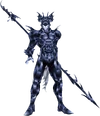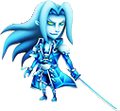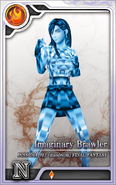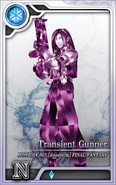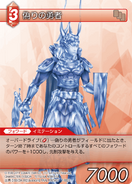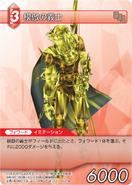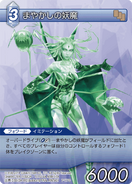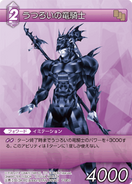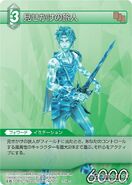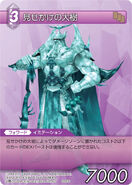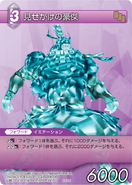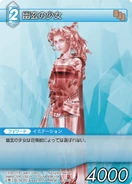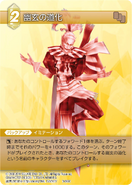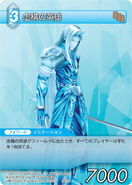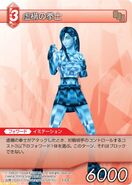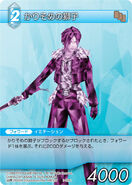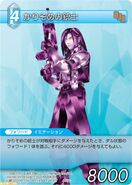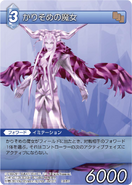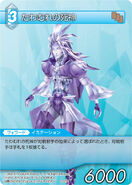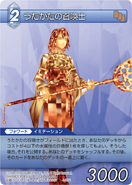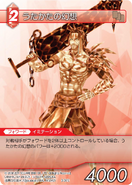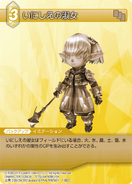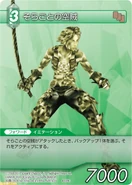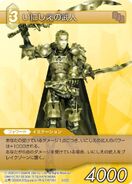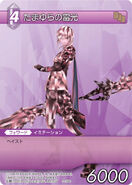Template:Sideicon
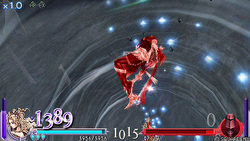
A Phantasmal Harlequin manikin is defeated.
Manikins are cursed mockeries of men that crawled forth from the Rift, and now befoul this realm. Their masters do no more than pull the puppets' strings.
Cloud of Darkness to Laguna
Manikins (イミテーション, imitēshon?, lit. imitations) are the main enemies encountered in Dissidia Final Fantasy and Dissidia 012 Final Fantasy. They appear as crystalline palette-swaps of the playable characters. In-game, they are represented by various Battle Pieces on the map board. A lot of the back story on manikins is told in the reports the player can read in the menu.
Story
Dissidia Final Fantasy posits manikins were created by Cid to give physical form to the consciousnesses that came from other dimensions, after viewing how Chaos and Cosmos "acquired pawns." His failures became manikins, incomplete puppets, which were sealed in the Rift. The successes are implied to be some of the warriors of Chaos and Cosmos, as the "created pawns" began to question "their very reason for living," and began to remember things from "their previous lives" after a purification. Who of the warriors are summoned or created is unknown, but it may be that the only summoned warriors are Garland, Gabranth, and Shantotto, while any of the other nineteen may be created.
This is retconned in Dissidia 012 Final Fantasy, where it is told the nation of Onrac from World A discovered a door to the Rift and retrieved a sample of crystal ore for study. The ore acts similar to an organic lifeform and grows as a living creature. Research on the sample resulted in mass production of simulated lifeforms made from the crystal ore, the first manikins. They remained formless until approached in their containment cell, at which point they took on the forms of the researchers observing them. They were but mindless puppets, and Cid was recruited to transplant memories into them to give them a sense of self.
Though it proved impractical for widespread use, Cid could implant a manikin with memories of ten other individuals, resulting in a manikin that resembled a grotesque monster but was the size of, and acted like, a human child. The child was placed in Cid's care for observation, and would grow up to become Chaos. Research continued with the manikins, and eventually the successful transplant of a complete set of memories to one was successful. This manikin was named Cosmos, and took the image of Cid's wife.
Most of the manikins failed to take on memories and were sealed in the Rift. After Cosmos, Chaos and Cid were transported to World B, Cid resumed his attempts to implant manikins with memories. He created the Warrior of Light from an infusion of his own memories, and sent him to fight in the cycles of war to observe his growth. Cid's failures prior to the Warrior's creation were disposed of in the same location as the other manikins.
During the twelfth cycle of the war, Exdeath releases the manikins as foot soldiers for Chaos. Due to their nature as mindless automatons, Garland and Ultimecia remark manikins will continue to fight even when their opponent is defeated and weak. Thus, if one is overwhelmed by manikins, they can be pushed to the brink of death and risk not having the strength to be revived in the next cycle. Though initially few in number, a massive horde of the creatures eventually sweeps across the land, separating the heroes as they fight to try and manifest their crystals. Their attention turns from the crystals to their concern for the deaths of their comrades at the hands of these new enemies.
The Cloud of Darkness considers the manikins to be abominations that disrupted a fragile balance in the world and reveals to Laguna where and how the manikins have crossed over. Afterwards, Laguna, along with Lightning, Kain, Tifa, Yuna, and Vaan, decide to track down the portal the manikins are using to enter the world and close it. An army of manikins marches on Order's Sanctuary to kill Cosmos, and save for the warriors seeking the portal, only the Warrior of Light remains to defend her.
Locating the portal in the Empyreal Paradox, the team defeats a few warriors of Chaos who try to stop them, and engage the manikins in a final battle, ultimately fading away, presumably to their respective worlds, but successfully closing the portal to the Rift and preventing any more manikins from emerging. Cosmos uses her power to save the Warrior of Light from the manikin army sent to destroy her, weakening her, but drastically reducing the number of manikins left.
Some members of both the warriors of Cosmos and warriors of Chaos have suspected that they may be advanced manikins rather than real humans during the twelfth cycle: Onion Knight and Zidane in particular discuss the possibility, and Sephiroth commits suicide to test whether he is indeed a manikin or the actual Sephiroth.
Gameplay
Manikins are colored in a manner reflective of their original counterpart or their counterpart's game of origin: Terra's manikin is red, Kuja's is purple, Warrior of Light's is blue, and so forth. Some manikins, like The Emperor's, use two colors. Manikins of different characters from the same game are the same or almost a similar color. Their voices are garbled, distorted versions of their counterparts, and their icon is the Battle Piece icon that represents them on the board.
Their naming system consists of an adjective alluding to their nature as transitory imitations, and a noun that describes their counterpart: Cloud's manikin is "Imaginary Soldier", while Golbez's is "Delusory Warlock". The exceptions are Prishe, Shantotto, and Gabranth, who have the naming system "[noun] of Antiquity". The adjectives that describe the manikins are synonymous and all manikins of characters from the same game share the same adjective, except for Final Fantasy XII, where Vaan's manikin has a different naming scheme to Gabranth's.
In battle, the manikin's power changes according to the type of Battle Piece that represents it. Manikins can perform any attack their original counterpart knows, but can execute them even if they are not a high-enough level to legitimately know them. The same goes for equipment: manikins may potentially equip any equipment piece they like regardless of its level requirement, even if their character counterpart cannot equip it innately. They can equip any number of the same accessory regardless of the accessory's rank, though they still may not equip more than ten. Manikins can equip support abilities, and all manikins have the basic Block, Dodge and Free Air Dash abilities.
Manikins can enter EX Mode, and as such can pick up EX Cores and absorb EX Force. Manikins share a single EX Mode titled "Powered Up!" in which they gain the Regen effect and have a greater likelihood to score critical hits. They do not gain any special abilities or attacks usable by their counterparts, cannot use EX Bursts, and keep the same appearance as their normal mode save for a glowing aura. The sole exception is Gabranth's manikin, which changes its appearance while in EX Mode and gains a different moveset like Gabranth himself does, but its EX Mode is still called "Powered Up!" and it still cannot use Gabranth's EX Burst.
In Dissidia 012 Final Fantasy, manikins use Assists, and are vulnerable to Assist Lock, Assist Break and EX Break. Manikins' Assists are other manikins, and in storyline battles Assists used by the Warriors of Chaos are manikins. Usually during the last battle of each Warrior of Cosmos, the ones that each Warrior of Chaos use, are manikins of their respective opposing Warrior of Cosmos.
In Dissidia Final Fantasy, some manikins give the player a chance to win a Destiny Point by fulfilling a requirement, such as scoring a critical hit within a time limit or preventing the opponent from picking up an EX Core. Manikins represented by Strange and Expert Battle Pieces always give the player a Destiny Point for winning in the Destiny Odyssey story modes, but in the other story modes they may not. In all story modes, defeating an Ultimate Battle Piece-level manikin awards two Destiny Points. In Dissidia 012 Final Fantasy, as Destiny Points are replaced by KP (Kupo), manikins allow the chance to win KP by fulfilling a preset requirement depending on the gateway shared across all manikins in this gateway.
In both games, depending on the stage, defeating a manikin may cause other items, including extra Battle Pieces, to appear on the stage. In Dissidia Final Fantasy, defeating a manikin may unlock a locked area, while in Dissidia 012 Final Fantasy, defeating them may cause previously vacant tiles on the board to appear and allow passage to new sections of the board.
List of manikins
Introduced in Dissidia Final Fantasy
| Name | Counterpart | Color | Image | Name | Counterpart | Color | Image |
|---|---|---|---|---|---|---|---|
| False Hero | Warrior of Light | Blue | 
|
False Stalwart | Garland | Blue | 
|
| Imitation Liegeman | Firion | Yellow and brown | 
|
Imitation Despot | The Emperor | Yellow and orange | 
|
| Counterfeit Youth | Onion Knight | Dark green | 
|
Counterfeit Wraith | Cloud of Darkness | Light green | 
|
| Delusory Knight | Cecil | Cobalt blue/Silver | 
|
Delusory Warlock | Golbez | Cobalt blue and silver | 
|
| Fallacious Wanderer | Bartz | Turquoise | 
|
Fallacious Tree | Exdeath | Turquoise | 
|
| Phantasmal Girl | Terra | Red | Phantasmal Harlequin | Kefka | Red | 
| |
| Imaginary Soldier | Cloud | Light blue | 
|
Imaginary Champion | Sephiroth | Light blue | 
|
| Transient Lion | Squall | Purple | 
|
Transient Witch | Ultimecia | Purple | 
|
| Capricious Thief | Zidane | Indigo | 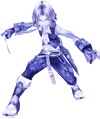
|
Capricious Reaper | Kuja | Light purple | 
|
| Ephemeral Vision | Tidus | Orange | 
|
Ephemeral Phantom | Jecht | Orange | 
|
| Lady of Antiquity | Shantotto | Brown | 
|
Warrior of Antiquity | Gabranth | Gold | 
|
Introduced in Dissidia 012 Final Fantasy
Introduced in Dissidia Final Fantasy NT
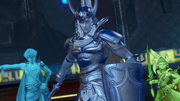
Manikins in Dissidia NT.
The manikins are enemies encountered during the main story, as well as during the different Gauntlet modes. In addition to new manikins, the naming and titles of returning ones have changed (with the exception of the Warrior of Light's manikin).
Unlike their predecessors, whose appearance were depicted by each polygon being colorized with their respective color and varying gradients, the Manikins in this tournament appear as their regular counterparts with tinted colorization and translucent rippling effects. When playing through any of the chapter-related Gauntlet challenges, the Manikins are shown as colorized version of their counterparts' 3D renders (as shown in the table below).
| Name | Counterpart | Color | Image | Name | Counterpart | Color | Image |
|---|---|---|---|---|---|---|---|
| False Hero | Warrior of Light | Blue | 
|
False Heretic | Garland | Blue | |
| Simulacrum of a Believer | Firion | Yellow | 
|
Simulacrum of a Tyrant | The Emperor | Yellow | 
|
| Illusory Youth | Onion Knight | Green | 
|
Illusory Apparition | Cloud of Darkness | Green | 
|
| Flickering Knight | Cecil Harvey | Dark Blue/Silver | Flickering Warlock | Golbez | Dark Blue | 
| |
| Echo of a Wanderer | Bartz Klauser | Turquoise | 
|
Arboreal Echo | Exdeath | Turquoise | 
|
| Fey Maiden | Terra Branford | Red | 
|
Fey Madcap | Kefka Palazzo | Red | 
|
| Ethereal Mercenary | Cloud Strife | Teal | 
|
Ethereal Savior | Sephiroth | Teal | |
| Otherworldly Lion | Squall Leonhart | Purple | 
|
Otherworldly Witch | Ultimecia | Purple | 
|
| Bandit's Caprice | Zidane Tribal | Violet | 
|
Reaper's Caprice | Kuja | Violet | 
|
| Fleeting Dream | Tidus | Orange | 
|
Fleeting Phantasm | Jecht | Orange | 
|
| Matron of Antiquity | Shantotto | Brown | 
|
Ersatz Sky Pirate | Vaan | Gold | 
|
| Evanescent Glimmer | Lightning | Pink | 
|
Mirage of a Conjurer | Y'shtola | Aquamarine | 
|
| Twilight Prince | Noctis Lucis Caelum | Black | 
|
Mutable Memory | Ramza Beoulve | Blue | 
|
| Discarded Delinquent | Ace | Red | 
|
Flickering Dragoon | Kain Highwind | Dark Blue | 
|
| Transient Pathfinder | Locke Cole | Red | 
|
Prudent Pugilist | Tifa Lockhart | Teal | 
|
| Otherworldly Maiden | Rinoa Heartilly | Purple | 
|
Fleeting Summoner | Yuna | Orange | 
|
| Archduke of Antiquity | Kam'lanaut | Brown | Ersatz Dynast | Vayne Carudas Solidor | Gold | 
| |
| Evanescent Guardian | Snow Villiers | Pink | 
|
Mirage of a Resonant | Zenos yae Galvus | Aquamarine | 
|
Introduced in Dissidia Final Fantasy Opera Omnia

Life's refreshing breeze, blow in energy! Cure!
Please refer to the Manual of Style or editing help to get started.
Manikins exist for each character released, with their color indicative of their current level range in the following sequence: silver (first tier) → sky blue (second tier) → green (third tier) → gold (fourth tier) → amethyst (fifth tier). Like the heroes, as their levels increase, so do their stats and abilities. They are not given thematic names as in other Dissidia titles.
| Name | Counterpart | Image | Name | Counterpart | Image |
|---|---|---|---|---|---|
| Maria Manikin | Maria | Edge Manikin | Edge | ||
| Rydia Manikin | Rydia | Palom Manikin | Palom | ||
| Yang Manikin | Yang | Lenna Manikin | Lenna | ||
| Galuf Manikin | Galuf | Faris Manikin | Faris | ||
| Krile Manikin | Krile | Shadow Manikin | Shadow | ||
| Edgar Manikin | Edgar | Sabin Manikin | Sabin | ||
| Celes Manikin | Celes | Setzer Manikin | Setzer | ||
| Relm Manikin | Relm | Aerith Manikin | Aerith | ||
| Yuffie Manikin | Yuffie | Cait Sith Manikin | Cait Sith | ||
| Vincent Manikin | Vincent | Cid Manikin | Cid | ||
| Quistis Manikin | Quistis | Zell Manikin | Zell | ||
| Seifer Manikin | Seifer | Fujin Manikin | Fujin | ||
| Raijin Manikin | Raijin | Vivi Manikin | Vivi | ||
| Garnet Manikin | Garnet | Steiner Manikin | Steiner | ||
| Beatrix Manikin | Beatrix | Wakka Manikin | Wakka | ||
| Seymour Manikin | Seymour | Lion Manikin | Lion | ||
| Penelo Manikin | Penelo | Ashe Manikin | Ashe | ||
| Hope Manikin | Hope | Snow Manikin | Snow (l'Cie) | ||
| Sazh Manikin | Sazh | Vanille Manikin | Vanille | ||
| Y'shtola Manikin | Y'shtola | Thancred Manikin | Thancred | ||
| Yda Manikin | Yda | Alisaie Manikin | Alisaie | ||
| Rem Manikin | Rem | Cater Manikin | Cater | ||
| King Manikin | King | Layle Manikin | Layle | ||
| Yuri Manikin | Yuri |
Allusions in nomenclature
- The overall use of adjectives for manikins is for opposing and derogatory meanings to that manikin's real counterpart, and on themes and elements from the installment which they come from.
- "False" for those of the original Final Fantasy refers to how the inhabitants of World B of Dissidia are related to the experiments done by Cid of the Lufaine. It is likely in juxtaposition of how the true Warriors of Light come forward to fight evil and champion peace in their mission to save the world.
- The Warrior of Light's manikin, the False Hero, alludes to the four Warriors of Light from the original game being the first playable protagonists of the series.
- Garland's manikin, the False Stalwart, alludes to Garland's unwavering loyalty to Chaos and the Great Will in the Dissidia series, and to the respect he had gained for his strength and his loyalty to Cornelia before falling from grace in the original game. This is further alluded to with his False Heretic manikin.
- "Imitation" for manikins of Final Fantasy II refers to a crucial theme of its story and the one thing that cannot be duplicated by impostors: the pursuit of personal ambitions and dreams. This is changed to "Simulacrum", alluding to the roles that the protagonist and antagonist play.
- Firion's manikin, the Imitation Liegeman, alludes to Firion's combat style of fighting with multiple weapons. The Simulacrum of a Believer manikin alludes to Firion representing hope and taking an active role among the Wild Rose Rebellion.
- The Emperor's manikin, the Imitation Despot, alludes to the Emperor's desire to take over his home world and to his similar goals in regards to World B in the Dissidia series. The Simulacrum of a Tyrant manikin alludes to the Emperor's reign of evil and his ascension as the ruler of Hell.
- The use of the "Counterfeit" for the Final Fantasy III fighters may allude to a recurring theme within its story, such as the protagonists' pursuit of the crystal in Goldor's Manor, the Four Old Men pretending to be the Warriors of Light, and Delilah accusing the protagonists of being imposters. The "Illusory" adjective could refer to the Floating Continent's separation from the Surface World by way of the mist shrouding the world, or it may be a reference to the Curse of the Five Wyrms in the final dungeon.
- The Onion Knight's manikins, the Counterfeit Youth and Illusory Youth, allude to the prophecy of the Gulgan that four youths will be blessed with light to stop a flood of darkness in Final Fantasy III.
- The Cloud of Darkness's manikins, the Counterfeit Wraith and Illusory Apparition, allude to her role of bringing death and nothingness to the world in Final Fantasy III and to her resemblance to a specter.
- The use of "Delusory" for the fighters from Final Fantasy IV refers to its story's theme of coming to a conscious decision to uncover the truth, including denouncing orders and allegiances from those who are not all that they seem to be. The "Flickering" adjective also alludes to the theme of changing alliances.
- Cecil Harvey's manikin, the Delusory Knight, alludes to Cecil's service as a knight to Baron. The Flickering Knight manakin specifically alludes to Cecil's transformation from Dark Knight to Paladin.
- Golbez's manikin, the Delusory Warlock, alludes to Golbez's powerful magical abilities, including teleportation, telepathy, high-level black magic, and summoning. The Flickering Warlock manikin alludes to Golbez breaking free from Zemus's control and aiding the protagonists in the final battle.
- Kain Highwind's manikin, the Delusory Dragoon, alludes to the job class that Kain is associated with. The Flickering Dragoon manikin alludes to Kain's path of redemption following his actions while under Golbez's control.
- The use of "Fallacious" for manikins of Final Fantasy V alludes to the theme of being drawn forth to the call of destiny, be it by mighty figures or the intuitions of one's heart. The "Echo" adjective alludes to this further, drawing parallels to the Warriors of Light's struggles being similar to those of the Warriors of Dawn.
- Bartz Klauser's manikins, the Fallacious Wanderer and the Echo of a Wanderer, allude to Bartz's ambition before being chosen as a Warrior of Light, which is to explore the world on his chocobo.
- Exdeath's manikins, the Fallacious Tree and the Arboreal Echo, allude to Exdeath being a tree from the Great Forest of Moore who harbors malevolent souls.
- Gilgamesh's manikin, the Fallacious Giant, alludes to Gilgamesh's size.
- The adjective of "Phantasmal" for manikins from Final Fantasy VI refers to its setting, including the Warring Triad and espers. At the end, the disappearance of magic makes the events of Final Fantasy VI seem but a fantastic dream. The "Fey" adjective specifically alludes to the concept of magic and espers being from another world, whereas the "Transient" adjective alludes to the recurring theme of how precious and fleeting life is.
- Terra Branford's manikin, the Phantasmal Girl, alludes to her being the youngest female character of the eleven warriors of Cosmos in the original Dissidia Final Fantasy. The Fey Maiden manikin alludes to Terra being half-esper and naturally imbued with magic.
- Kefka Palazzo's manikin, the Phantasmal Harlequin, alludes to Kefka's clown-like appearance, to his jokes, and to his role in both Final Fantasy VI and the Dissidia series as a source of comic relief. The Fey Madcap manikin alludes to Kefka's ascension to a god-like being, as well as his general disregard for life and thirst for destruction.
- Locke Cole's manikin, the Transient Pathfinder, alludes to his travels as an adventurer in search for the Phoenix magicite to revive his former love.
- "Imaginary" for manikins from Final Fantasy VII may refer to its theme of the perception of the world, including the choice of accepting harsh but honest truths in one's experiences and perspectives, which shape oneself. "Ethereal" further alludes to this, more specifically the Lifestream and its role in maintaining balance throughout the world.
- Cloud Strife's manikin, the Imaginary Soldier, alludes to how Cloud had dreamed of joining Shinra's elite fighting force, SOLDIER, since he was a boy. The Ethereal Mercenary manikin alludes to Cloud's involvement with the AVALANCHE group as well as his struggle with his memory and past.
- Sephiroth's manikin, the Imaginary Champion, alludes to Sephiroth being considered the most legendary fighter of Shinra's SOLDIER program, and was thus idolized by the public. The Ethereal Savior alludes to Sephiroth's belief that he is the rightful ruler of the planet.
- Tifa Lockhart's manikin, the Imaginary Brawler, alludes to Tifa's martial arts skills and to her tomboyish personality.
- "Transient" for manikins from Final Fantasy VIII has a temporal and time-related element; the fleeting past versus cherished memories is a prevalent theme in Final Fantasy VIII. The "Otherworldly" adjective further alludes to this, as well as the effects of time compression sending the characters into both the past via dream sequences, and into the future through sorceress magic.
- Squall Leonhart's manikins, the Transient and Otherworldly Lion, allude to Squall's admiration of lions due to their courage and strength. Lions serve as a recurring motif for him.
- Ultimecia's manikins, the Transient and Otherworldly Witch, allude to Ultimecia being a sorceress, a human who can use magic naturally in the world of Final Fantasy VIII. The noun "witch" is a synonym of the noun "sorceress", and is what they were known as in the Japanese version.
- Laguna Loire's manikin, the Transient Gunner, alludes to Laguna's musical theme and to his job class.
- Rinoa Heartilly's manikin, the Otherworldly Maiden, alludes to the Rinoa's role as Squall's love interest and to being a young female.
- "Capricious" for manikins from Final Fantasy IX juxtaposes the game's emotional themes and core where its lighthearted nature remains even for scenarios of death and gloom, and to the convictions of its main characters, who continue fighting for what they believe in even in the face of change. "Caprice" alludes to the reaction each character has when first faced with said changes and revelations.
- Zidane Tribal's manikins, the Capricious Thief and Bandit's Caprice, allude to Zidane's job class and to his occupation in the Tantalus Theater Troupe.
- Kuja's manikins, the Capricious Reaper and Reaper's Caprice, allude to him being the "Angel of Death" whose job is to return Gaian souls to the planet.
- "Ephemeral" for manikins from Final Fantasy X alludes to death and the presence of the spiritual throughout the world of Spira. It also likely refers to the negative aspects of ephemerality, including how peace makes way for future conflicts. The "Fleeting" adjective further alludes to this, notably referring to the Calm that transpires once a summoner has vanquished Sin. "A Fleeting Dream" is a track on the Final Fantasy X: Original Soundtrack that refers to the dreams of the fayth and how they will disappear.
- Tidus's manikins, the Ephemeral Vision and Fleeting Dream, allude to him being a dream of the fayth.
- Jecht's manikins, the Ephemeral Phantom and Fleeting Phantasm, also allude to him being a dream of the fayth; Phantom implies more haunting and taunting meaning, further defining him as a negative figure in the life of Tidus.
- Yuna's manikins, the Ephemeral Summoner and Fleeting Summoner, allude to her job class and to the key role she plays in Spira.
- "Antiquity" for manikins of Final Fantasy XI alludes to the world of Vana'diel being of an age of adventure and a world resembling the medieval times of yore that inspired the modern day fantasy genre.
- Shantotto's manikin, the Lady of Antiquity, alludes to her being the oldest of the eleven warriors of Cosmos in the original Dissidia Final Fantasy, and to her status as a skilled mage in the world of Vana'diel. This is further alluded to with her Dissidia Final Fantasy NT manikin, the Matron of Antiquity.
- Prishe's manikin, the Horror of Antiquity, alludes to how Prishe was referred to as the "Abhorrent One" in Final Fantasy XI.
- Kam'lanaut's manikin, the Archduke of Antiquity, alludes to his given title in the Grand Duchy of Jeuno in Final Fantasy XI.
- "Idle" for those of Final Fantasy XII juxtaposes its themes of adventure and chasing one's heart's desires in the heralded Golden Age of Ivalice. The use of the specifier "of Antiquity" may also count, for reasons that apply the same for the world of Vana'diel as an age of adventure. This is changed to "Ersatz", which alludes to the theme of deception and betrayal through false intentions.
- Vaan's manikins, the Idle and Ersatz Sky Pirate, allude to his dreams of becoming one.
- Gabranth's manikin, the Warrior of Antiquity, alludes to Archadian Judges being considered "noble warriors".
- Vayne Carudas Solidor's manikin, the Ersatz Dynast, refers to his importance as a member of the House of Solidor, and goal to become the Dynast King of Ivalice.
- "Fleeting" for those of Final Fantasy XIII likely refers to its cosmology and theology as the core installment of the Fabula Nova Crystallis universe, being that of a world where human life is related with mortality and death. It may also refer to how the main characters have a time limit for completing their shared Focus. "Evanescent" alludes to the story of Lightning Returns: Final Fantasy XIII, emphasizing the oncoming Apocalypse.
- Lightning's manikins, the Fleeting Flash and Evanescent Glimmer, allude to the conversation she had with Hope about her choice of name: "Lightning. It flashes bright, then fades away. It can't protect. It only destroys."
- "Mirage" used for fighters of Final Fantasy XIV refers to the player character's visions portraying a goal they must work towards, and the introduction to the Scions of the Seventh Dawn society.
- Y'shtola's manikin, the Mirage of a Conjurer, alludes to her moniker as a "Cultured Conjurer" and refers to her role as a spellcaster in battle.
- For fighters from Final Fantasy XV, "Twilight" alludes to the central theme of finding one's self in the face of a bleak future, as well as the ambition of the main antagonist to envelop the world in an eternal night.
- Noctis Lucis Caelum's manikin, the Twilight Prince, refers to Noctis's initial title as the prince of Lucis.
- "Mutable" for fighters from Final Fantasy Tactics alludes to how magick fades from Ivalice and how in the future the truth becomes to seem implausible due to the fantastical becoming impossible. The Church of Glabados endeavors to cover up their crimes and destroys any compromising evidence against it.
- Ramza Beoulve's manikin, the Mutable Memory, alludes to him being deemed a heretic for his part in exposing the church's crimes and rebelling against them, and how the House of Beoulve is considered deceased as a result.
- For fighters from Final Fantasy Type-0, "Discarded" alludes to the artificiality of Orience and its inhabitants seen as nothing but subjects in a divine experiment, including how the dead are treated as of little loss with all memory of the deceased removed to prevent any hesitation, an erasure done by the four Crystals. Class Zero strove to become Agito, but the Judge rejected them for the role.
- Ace's manikin, the Discarded Delinquent, alludes to his role as a cadet, and possibly refers to his defiance against the Vermilion Bird Crystal by refusing to become a l'Cie.
Other appearances
Theatrhythm Final Fantasy Curtain Call
These imitation warriors take on the form of famous heroes of the ages. While they have no souls of their own, they do possess all of the originals' power and skill. There will be no rebirth for these shells, only annihilation.
Manikin's CollectaCard
Sephiroth's manikin, the Imaginary Champion appears as an enemy, mainly fought in Battle Music Sequence from Dissidia Final Fantasy and Dissidia 012 Final Fantasy.
Pictlogica Final Fantasy
The False Hero, Imitation Liegeman, Delusory Warlock, Phantasmal Harlequin and Transient Lion appear as enemies in the Dissidia Final Fantasy special events.
Final Fantasy Artniks
Manikins appear as character cards.
Final Fantasy Trading Card Game
Several manikins appear as trading cards. Reflecting their roles in Dissidia Final Fantasy, they act as support for Exdeath's cards, able to be summoned en masse by him and being powered up by him or vice versa, and they can bypass the standard rule that states only three copies of a single card can be in a deck. Many have abilities that mirror the effects of their original counterparts, but with less potency—for example, one of Bartz's cards makes all the player's Wind Forwards active when played, while the Fallacious Wanderer makes up to two Wind Forwards active.
The trading card for Fallacious Wanderer depicts it wielding the Brave Blade, but as manikins do not share their counterpart's EX Mode, there is no way for the Fallacious Wanderer to wield the weapon in-game.
Etymology
Mannequin, also known as mannequin, is an articulated doll or dummy used mainly by artists, tailors, and dressmakers. The name is befitting to the role of these characters as crystal embodiments.
Trivia
- The concept of living crystal is also seen in the Final Fantasy V Interdimensional Rift, where crystal enemies called Crystelles are common. It is also seen in the Final Fantasy IX Crystal World, where crystalline replicas of the four Guardians of Terra are fought as random encounters. Living crystal creatures also appear in Final Fantasy XIII-2 where two "crystalspawn" bosses (Pacos Luvulite and Pacos Amethyst) are fought.
- Feral Chaos is the only playable character not to have a manikin counterpart. The weaker version of him encountered in the South Lufenia Gateway uses his alternate outfit, which gives it a somewhat manikin-like appearance, and is referred to as being similar to a manikin.
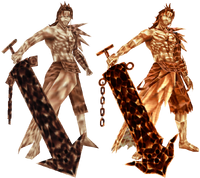
Comparison of Jecht's manikins for cutscenes and battle.
- The manikins in cinematic sequences use different models from those normally encountered, and have smoother textures with duller coloring and a lower polygon count.
- Vaan's and Lightning's manikins in Dissidia 012 Final Fantasy are the only ones with a unique adjective in their titles (Idle and Fleeting respectively).
- It is possible to play as a manikin in Dissidia 012 Final Fantasy using CWCheat codes and CFW. These manikins cannot enter EX Mode.
- Various manikin models include aspects of their original counterpart's EX Mode in their data files, many having their counterpart's EX Mode weapons despite manikins not gaining them when entering EX Mode. Said weapons are even recolored to match the manikin's color scheme. Bartz's manikin, the Fallacious Wanderer, also has Bartz's EX Mode cape and the stars over its head.
- In Dissidia Final Fantasy NT the returning characters have their player names set by default as "Nameless" followed by their respective manikin nouns.
- The noun used for the Warrior of Light's default player name is "Guardian" instead of "Hero".
- The noun used for Firion's default player name is "Idealist" instead of "Liegeman".
- The noun used for the Onion Knight's default player name is "Boy" instead of "Youth".
- The noun used for Kefka Palazzo's default player name is "Madcap" instead of "Harlequin".
- The noun used for Sephiroth's default player name is "Hero" instead of "Champion".
- The noun used for Ultimecia's default player name is "Sorceress" instead of "Witch".
- The noun used for Zidane Tribal's default player name is "Brigand" instead of "Thief".
- The noun used for Kuja's default player name is "Angel of Death" instead of "Reaper".
- The noun used for Tidus' default player name is "Dreamer" instead of "Vision".
- The noun used for Jecht's default player name is "Illusion" instead of "Phantom".
- The noun used for Shantotto's default player name is "Matron" instead of "Lady".
- The noun used for Y'shtola's default player name is "Scion" instead of "Conjurer".
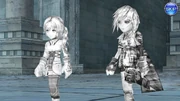
Dark Imitation of Serah and Lightning.
- With the inclusion of Locke in Dissidia Final Fantasy NT, his manikin title bears a different name than that of Terra and Kefka. This is likely a translation oversight.
- Stronger versions called "Dark Imitations" appear in Dissidia Final Fantasy Opera Omnia.

